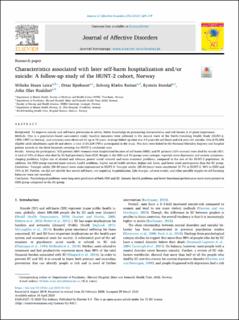| dc.description.abstract | Background
To improve suicide and self-harm prevention in adults, better knowledge on preexisting characteristics and risk factors is of great importance.
Methods
This is a population-based case-control study; baseline measures were collected in the second wave of the North-Trøndelag Health Study (HUNT-2, 1995–1997) in Norway, and outcomes were observed for up to 19 years. Average follow up time was 4.9 years for self-harm and 6.8 years for suicides. Out of 93,898 eligible adult inhabitants aged 20 and above, a total of 65,229 (70%) participated in the study. The data were linked to the National Mortality Registry and hospital patient records in the three hospitals covering the HUNT-2 catchment area.
Results
Among the participants, 332 patients (68% women) were hospitalized because of self-harm (HSH), and 91 patients (32% women) were died by suicide (SU). A total of 10% of those who died by SU had previously been HSH. People in the HSH and SU groups were younger, reported more depression and anxiety symptoms, sleeping problems, higher use of alcohol and tobacco, poorer social network and more economic problems, compared to the rest of the HUNT-2 population. In addition, the HSH group reported more somatic health problems, higher use of health services, higher sick leave, and lower work participation than the SU group.
Limitations
Younger adults (20–40 years) were under-represented in HUNT-2. Younger adults (20–40 years) were constituted 31.7% in HUNT-2, 50% in HSH and 33% in SU. Further, we did not identify less severe self-harm, not requiring hospitalization. Life changes, adverse events, and other possible triggers to self-harming behavior were not recorded.
Conclusion
Psychological problems were long-term predictors of both HSH and SU. Somatic health problems and lower functional performance were more present in HSH-group compared to the SU-group. | en_US |

